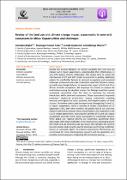| dc.description.abstract | Despite the existing literature on climate variability (CV) and land use
change (LUC) impact assessments, understanding their effectiveness in
semi-arid regions remains challenging. This review aims to assess the
effectiveness of CV and LUC impact assessments in guiding adaptation
options for smallholder farmers in semi-arid ecosystems and associated
challenges and opportunities. We conducted a systematic literature review,
primarily using Google Scholar, to examine the impact of LUC and CV in
African semi-arid ecosystems. We employed Vos Viewer to analyze the
relationships among the identified sources. Our findings reveal that current
assessment approaches often fall short in capturing the intricate
interactions within semi-arid ecosystems. These assessments frequently
emphasize biophysical productivity, employ reductionist modeling
methods, and neglect the social, economic, and adaptive aspects of these
systems. Our review underscores the importance of integrating CV and LUC
in impact assessments. While a majority of studies concentrate on CV
adaptation (26%), they often overlook the pivotal role of LUC and their
interplay with climate impacts. Only a small fraction (2%) integrates CV and
LUC in impact assessments. Assessing the benefits of CV and LUC impact
assessments presents mixed results, particularly for smallholder farmers.
While global and regional benefits are discernible, quantifying these
advantages at the local smallholder farmer level remains challenging due to
diversified land use and small-scale operations. This highlights the need for
localized studies addressing the specific challenges confronting smallholder
farmers in semi-arid regions. To enhance assessments effectiveness, we
recommend for more interdisciplinary research and the application of a
complex systems approach, integrating GIS and remote sensing. | en_US |


